Step into the cramped hall of Jordan’s Souk el-Khodra, the Amman Vegetable Market, and the aroma is the first thing you notice. Certainly, the colors are dazzling – the bright green of raw chickpeas, deep purple of sumac, golden turmeric, and dozens more vibrant provisions decorate brimful tables. Meanwhile, the ambient haggling in Jordanian Arabic provides a melodic soundtrack.

Exploring the Local Side of Jordan Through Its Sights, Aromas, and Flavors
But it’s the scents that captivate. Many vendors have their own roasting ovens, which gently spin as they roast peanuts, tree nuts, and watermelon seeds, emitting their rich perfumes. These creamy, wafting smells mix with warm hints of cardamom, cinnamon, and clove and are sprinkled with the pungent perfume of thyme, fenugreek, marjoram, and countless more herbs.
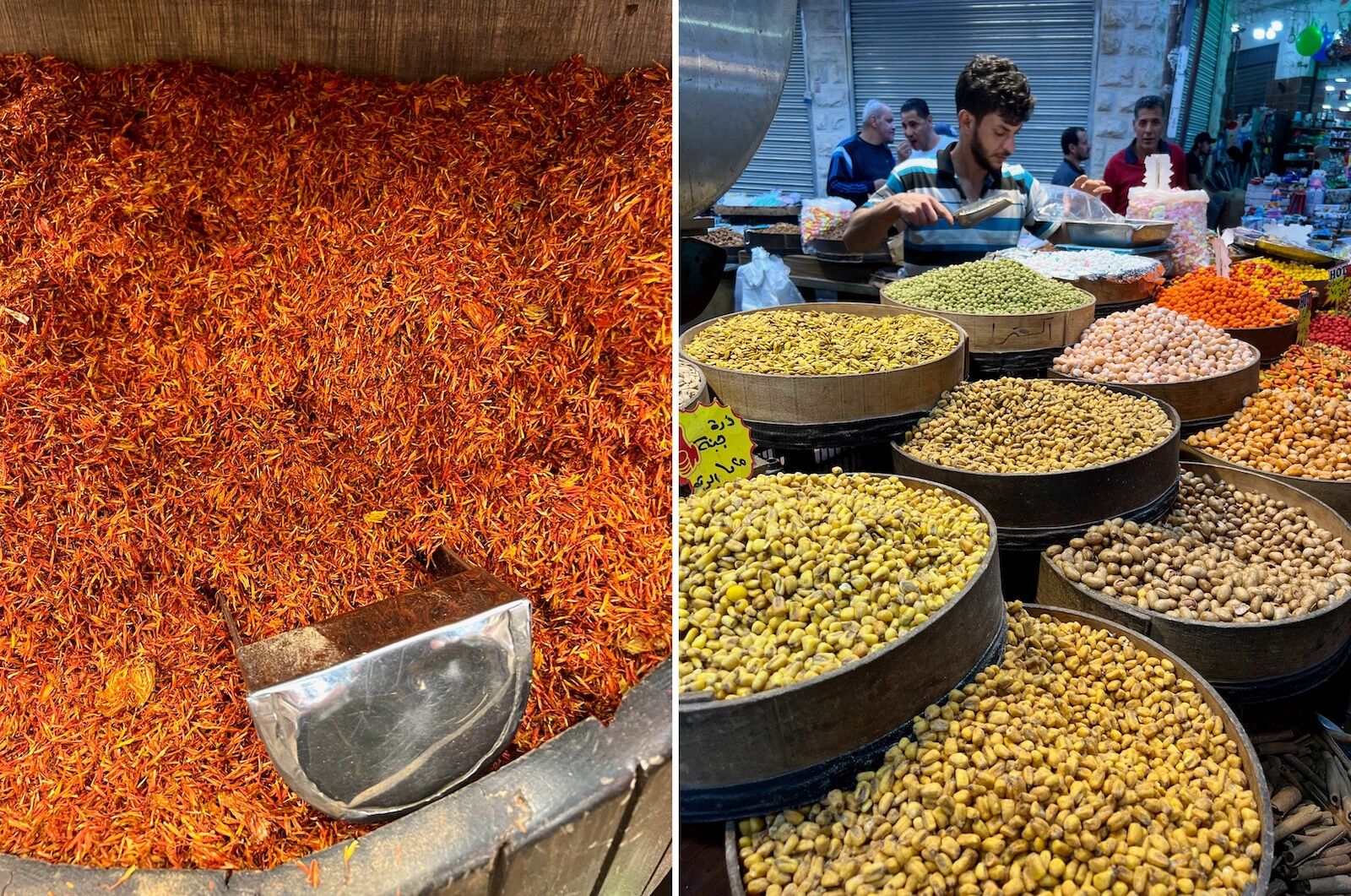
Photo: Noelle Salmi
Our guide at the market and throughout the week is Moayad Al Otaibi. The son of a chef, Otaibi studied in kitchens and studied archeology in college, making him the perfect guide for a pilot tour of Jordan oriented on food to be offered by the travel company Explore Worldwide. The seven-day trip costs between $1470 to $1630, excluding flights, with a $530 surcharge for single-occupancy travelers. Explore Worldwide works with local providers to design journeys, which can last from four days to three weeks and are bookable three months to over a year in advance.
The Vegetable Market is located near an ancient amphitheater in the oldest part of Amman. At a shop just next door to it are yet more spices, offered up as dried leaves and berries or ground into powders. Many are blended into combinations to be purchased whole or crushed – among them several versions of za’atar, a mix of thyme and sesame that may also contain other herbs and spices. In Jordan, za’atar often includes the lemony tartness of sumac.
“Almost all the spices come from India,” Otaibi says. “We use the same spices, but with Middle Eastern flavors.”
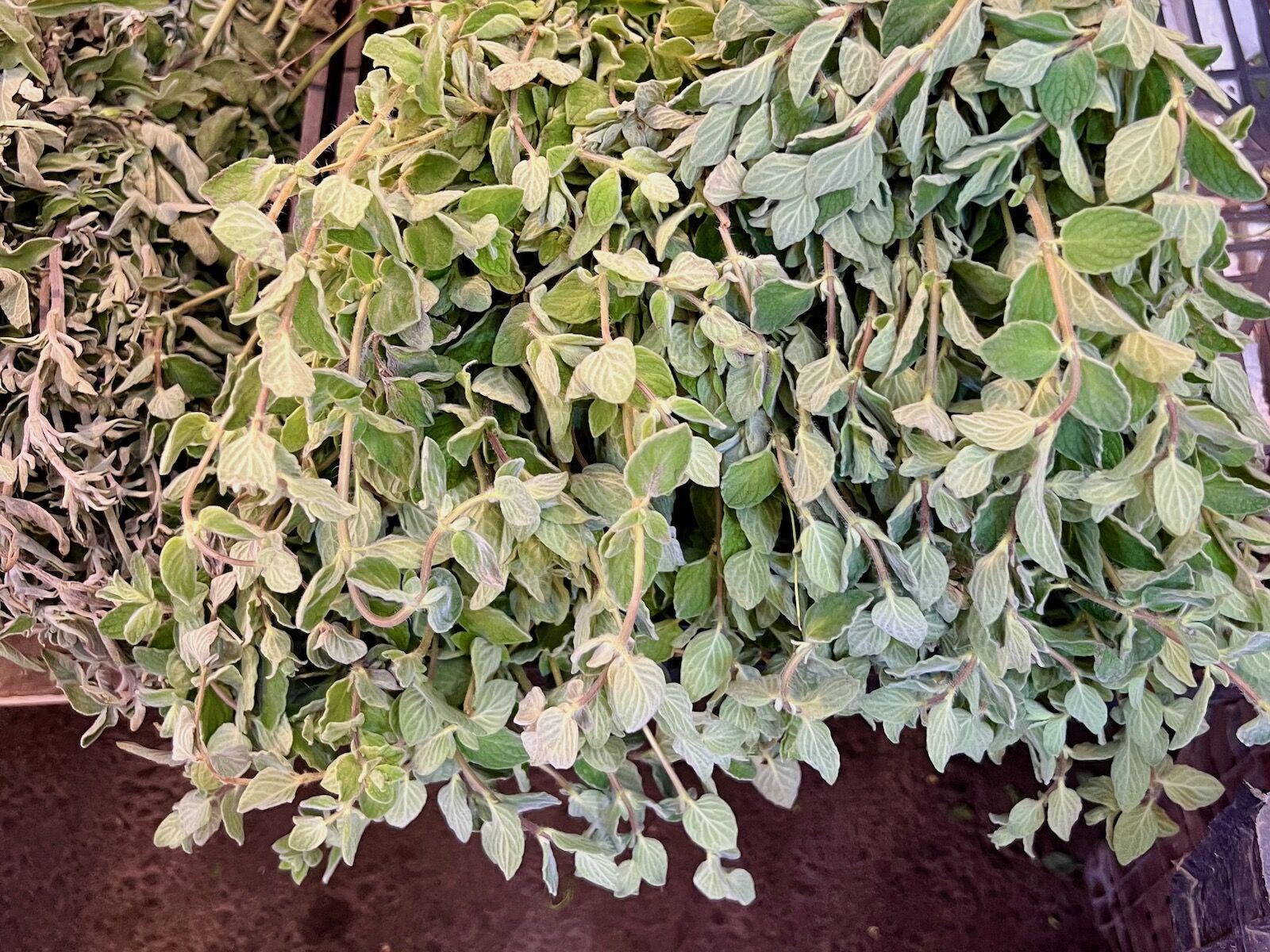
Photo: Noelle Salmi
Al Otaibi, an Amman native, is passionate about his country’s cuisine and enthusiastically details how to prepare each dish we encounter. On our trip we’ll admire Jordan’s deservedly famous highlights, Petra and the Wadi Rum desert, while also visiting village bakeries and dairies, hiking through fields of wild herbs, and helping cook our meals.
A trip to the Ajloun Forest Reserve in 3,500-foot hills north of Amman gives us a first taste of Jordanian flavors and hospitality. On our journey there, we pass the Jerash region, home not only to extensive Roman ruins but to copious olive groves. At the reserve itself, a workshop converts olive oil from those groves into moisturizing soap bars, either plain or enriched with ingredients like pomegranate and oatmeal.
Next door, the Biscuit House bakery turns out sheets of redolent cookies flavored with cardamom, honey, pistachio, or ginger and filled with dates, tahini, or honey. Alongside them are savory biscuits of fennel, olive oil, or thyme and cheese. Energized by the tasty confections, we hike quickly through forests of carob, pistachio, and evergreen oaks in comfortable mountain temperatures.
We end our trek just beyond the reserve, where lunch prepared in a family home by Eman Dwekat and served by her sons is a delight. A roasting pan called a sawani holds chicken that’s been marinated overnight in garlic and lemon and slow roasted with eggplant and potatoes, while another holds minced lamb served with sauteed onions and spices. The meal also features rice tinted bright yellow by turmeric and saffron, and mutabal, which is a baba ganoush with tahini.
Two additional dishes – mashed potatoes wrapped in filo dough and chicken with onions and sumac rolled in thin bread called shrak – hint at the importance of bread in Jordanian cuisine. The meal is capped by the arrival of a golden tray bearing small glass cups filled with bright, mahogany-hued tea infused with sage leaves. The aroma is so intoxicating that I sip the tea as slowly as possible to keep breathing in the musky, verdant fragrance.
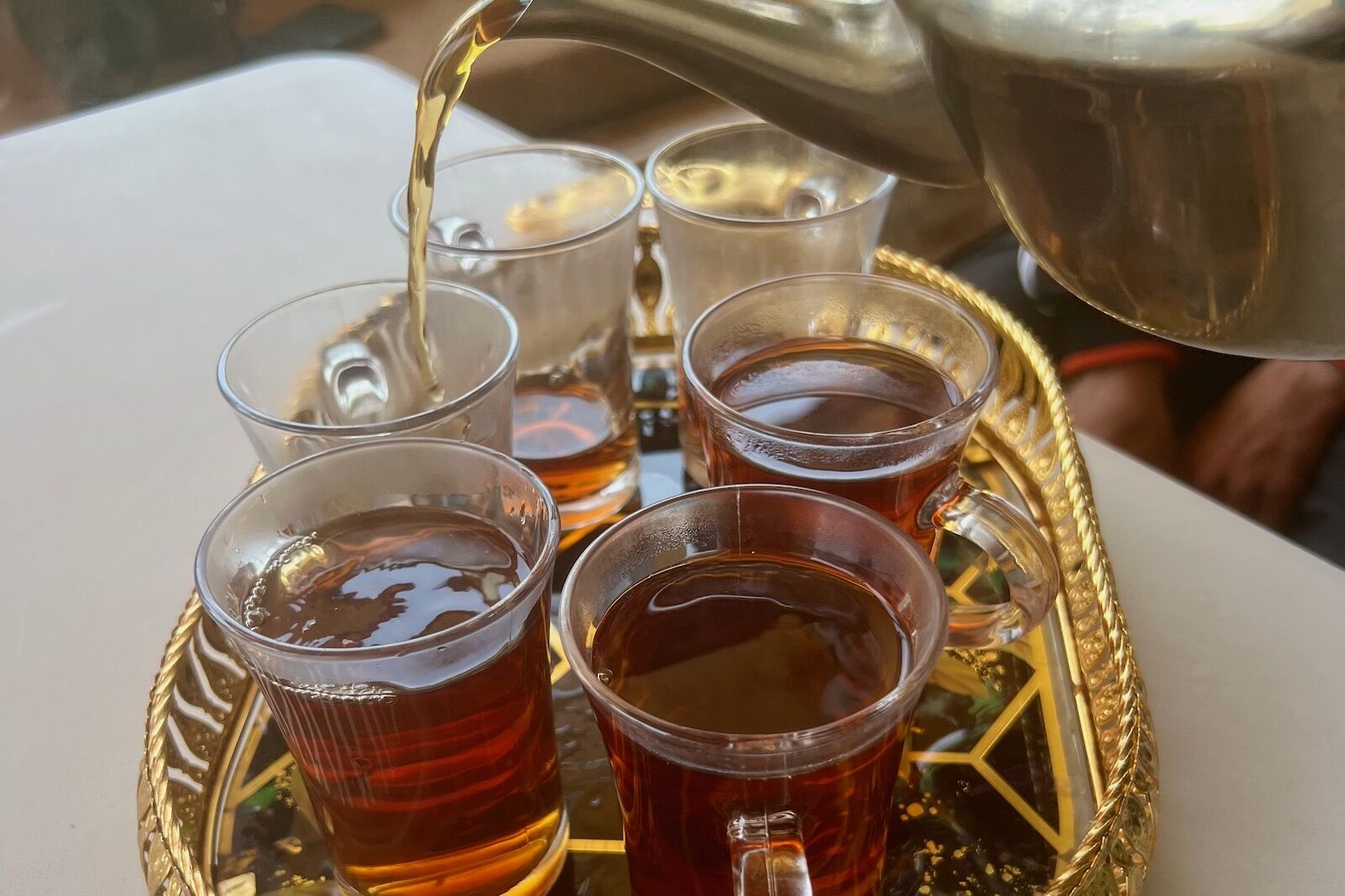
Photo: Noelle Salmi
“In Jordan, we love the tea with any flavor. Not milk, no. Sage or cinnamon, mint, cardamom, thyme, any of these herbs we add to the tea. Or we make a mixture,” says Al Otaibi.
I try another herb the next day in the Dana Biosphere Reserve, a 120-square-mile haven for hundreds of unique animals like sand cats and Nubian ibexes, over 200 bird species, and hundreds of plant species, many endemic. Midway through a hike past Aleppo pines, white pines, and balut oaks we stop to rest atop a rocky outcrop. Granite peaks topping 4,500 feet soar to our right, limestone and sandstone hills lay before us, while, to our left, the desert stretches into the distance.
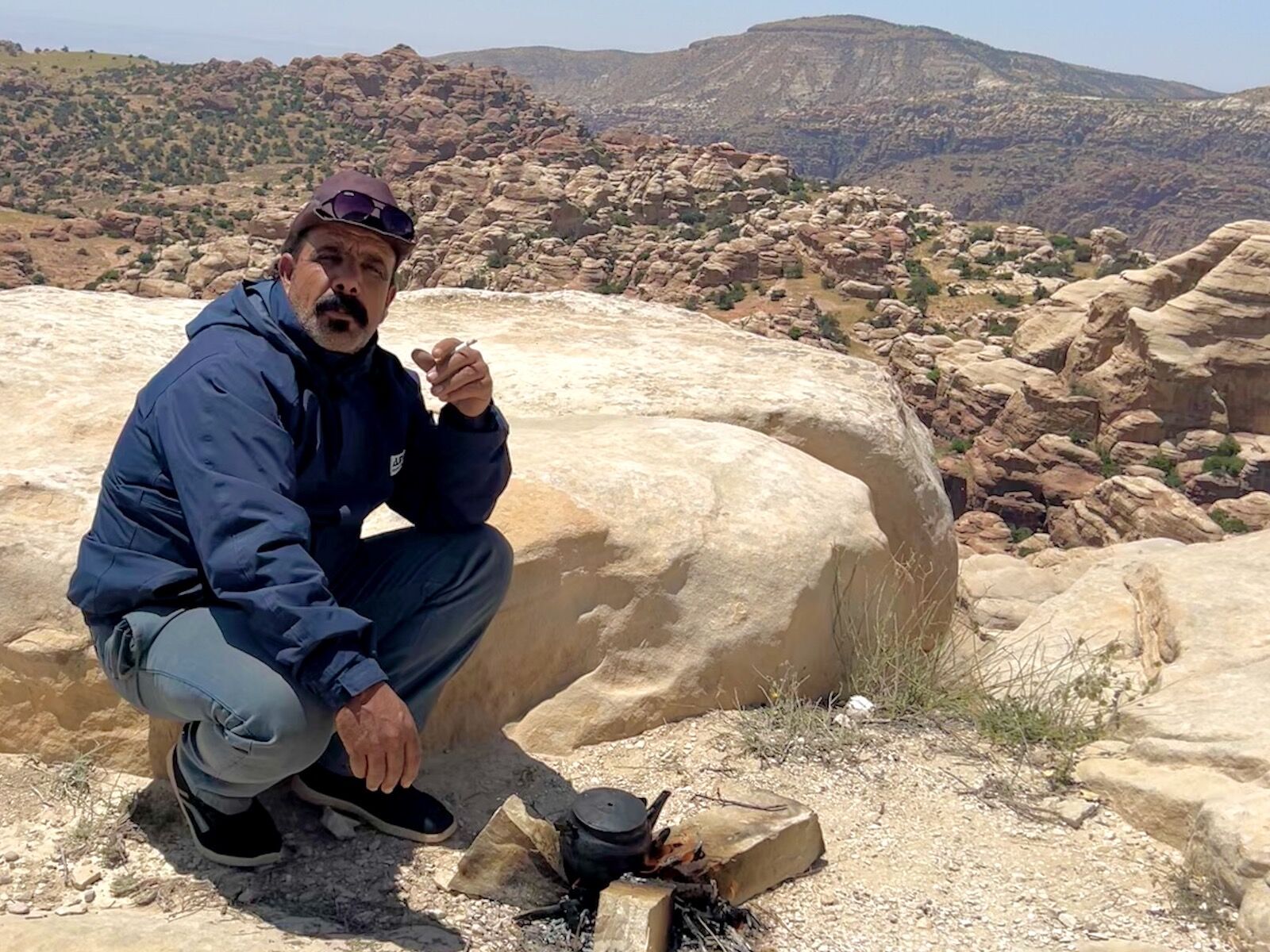
Photo: Noelle Salmi
Our hiking guide Ahmed Ali heats up tea in a dented metal teapot over a small, open flame and adds in an herb that he’s gathered on our walk. Ali serves it in tiny paper cups, and I’m greeted by the wafting scent of artemisia. Once again, a few sprigs have transformed a simple cup of tea.
The vast terrain we see, from the sub-sea-level sands to the stony mountains, belongs to the Dana Biosphere. In the cool breeze, Al Otaibi explains, “The Bedouin does not change the clothes. They change the location. In the summer, they come to the mountains. In the winter, they are in the desert.”
Jordan is home to several Bedouin tribes that still inhabit its desert areas, as well as urban residents who are proud of their sometimes distant Bedouin heritage. While 92 percent of Jordanians are Muslim, eight percent of the population identifies as Christian, in a mix of Catholic, Orthodox, and Protestant denominations. In Jordan, you won’t find alcohol in most locally owned hotels and restaurants, but liquor stores carry wines produced by two well-known Jordanian Christian vintners, Zumat and Haddad.
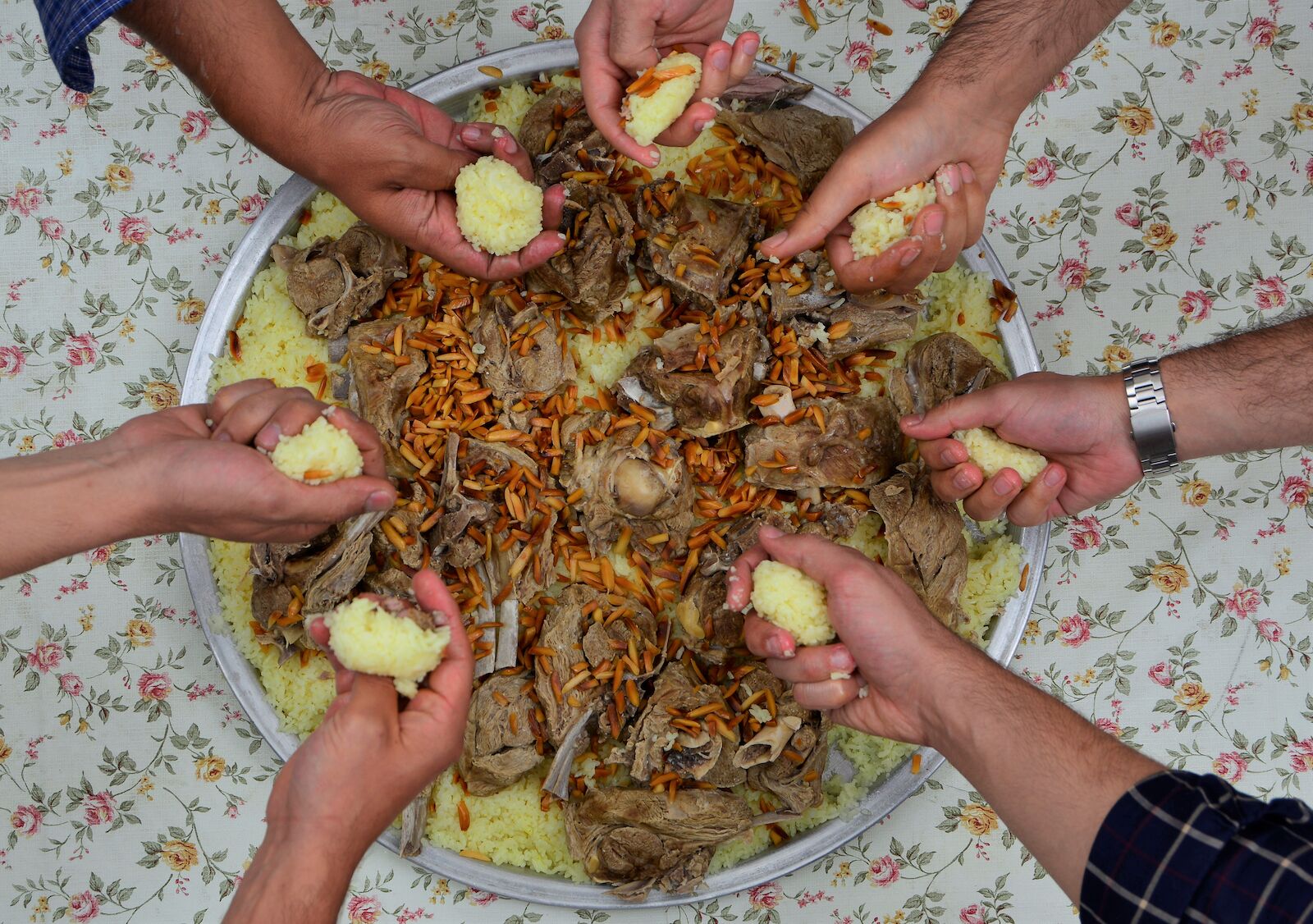
Photo: PhotoHunterQais/Shutterstock
While each region has its own specialties, Jordan’s national dish is rooted both in its Bedouin desert history and its legacy as a cultural crossroads. Mansaf is usually made with lamb, which is slow-cooked in a rich yogurt sauce and served over rice atop a layer of shrak bread. Mansaf is served for lunch at every Jordanian wedding, sometimes to hundreds of guests, who partake in the meal while standing.
To discover the source of mansaf’s distinct taste, we travel south to the desert, stopping in the village of Al Shobak. There, a local women’s cooperative makes Mansaf’s essential ingredient to sell to the community: laban jameed, or “hard yogurt.”
Inside a basic concrete building, a mass that looks like whitish clay is drying amid layers of sheets on the floor. A sample reveals it tastes like a cross between strained yogurt and feta. Behind it, trays display white and yellow orbs the size of grapefruits. These are dried balls of labneh, a yogurt-cheese, and the yellow ones have been seasoned with turmeric.
Although labneh is a Bedouin tradition, camel milk is unsuitable for it, as it’s too low in fat, says Al Otaibi. However, camel milk is rich in protein and vitamins, he says, adding, “A glass of camel milk and some dates is an excellent breakfast.”
Labneh is instead made from goat and sheep milk, which is salted, shaped into spheres, and dried. In the desert’s arid climate, labneh balls last several months unrefrigerated and are always at hand. That matters, since according to Bedouin tradition one should be prepared to cook Mansaf at a moment’s notice.
Should a stranger come to you in the desert, you must take them in. You will then kill one of your sheeps or goats, boil the meat, then add a dried labneh ball to the broth to make the rich Mansaf sauce. Only after you have served the Mansaf on its bed of golden rice and your guest has had their fill, may you and your family dine on what is left. Jordanians say that the need to treat newcomers with respect arose from life in harsh desert conditions.
Even before trying Mansaf at the end of the week, I experience Jordanian hospitality with each encounter, be it a shopkeeper, business owner, or taxi driver. Again and again I hear, “You’re welcome. Welcome to Jordan.”
The spiced rice on which Mansaf is served doesn’t grow in the desert, but we grasp its origins when we visit Petra the next day.
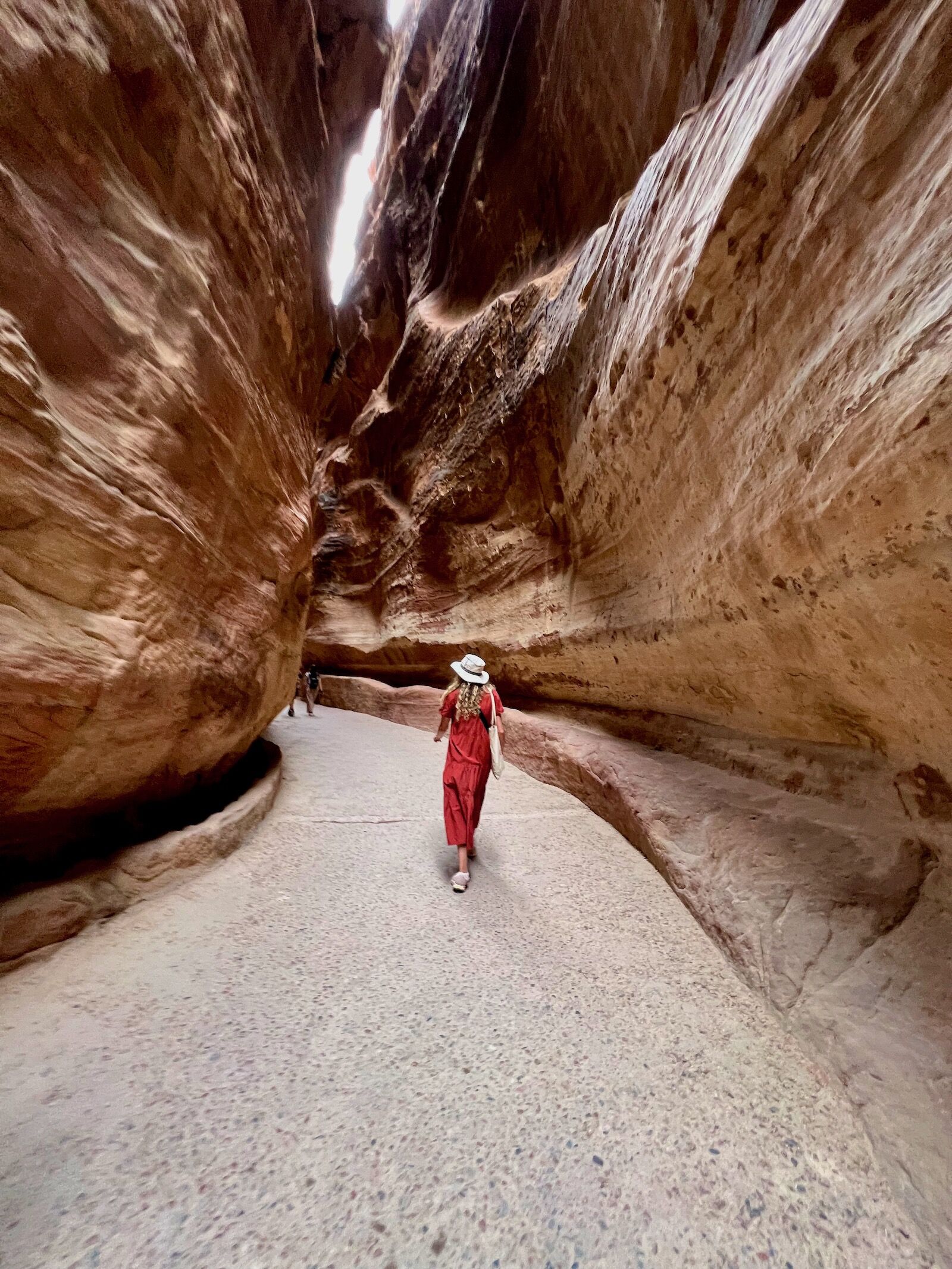
Photo: Noelle Salmi
Petra’s dramatic topography is the result of three tectonic plates pushing a 500 million-year-old seabed upwards – producing swirling sandstone features, sheltered glens, and narrow canyons. The formations were so remarkable and useful that the Nabateans, possibly a Bedouin tribe who arrived there from Yemen over two millennia ago, worshiped the gods of the mountains.
The Nabateans became excellent traders who eased the flow of spices, incense, and textiles between Asia, Egypt, Greece, and Rome. They also helped move metals like gold, iron, and copper and many other items. In the 1.2-mile entrance into Petra through the Siq canyon, or “narrow passage,” you’ll spot a faint carving in the sandstone wall: that of a camel trader, with camels moving both in and out of Petra. The carving attests to the centrality of trading to Nabateans.
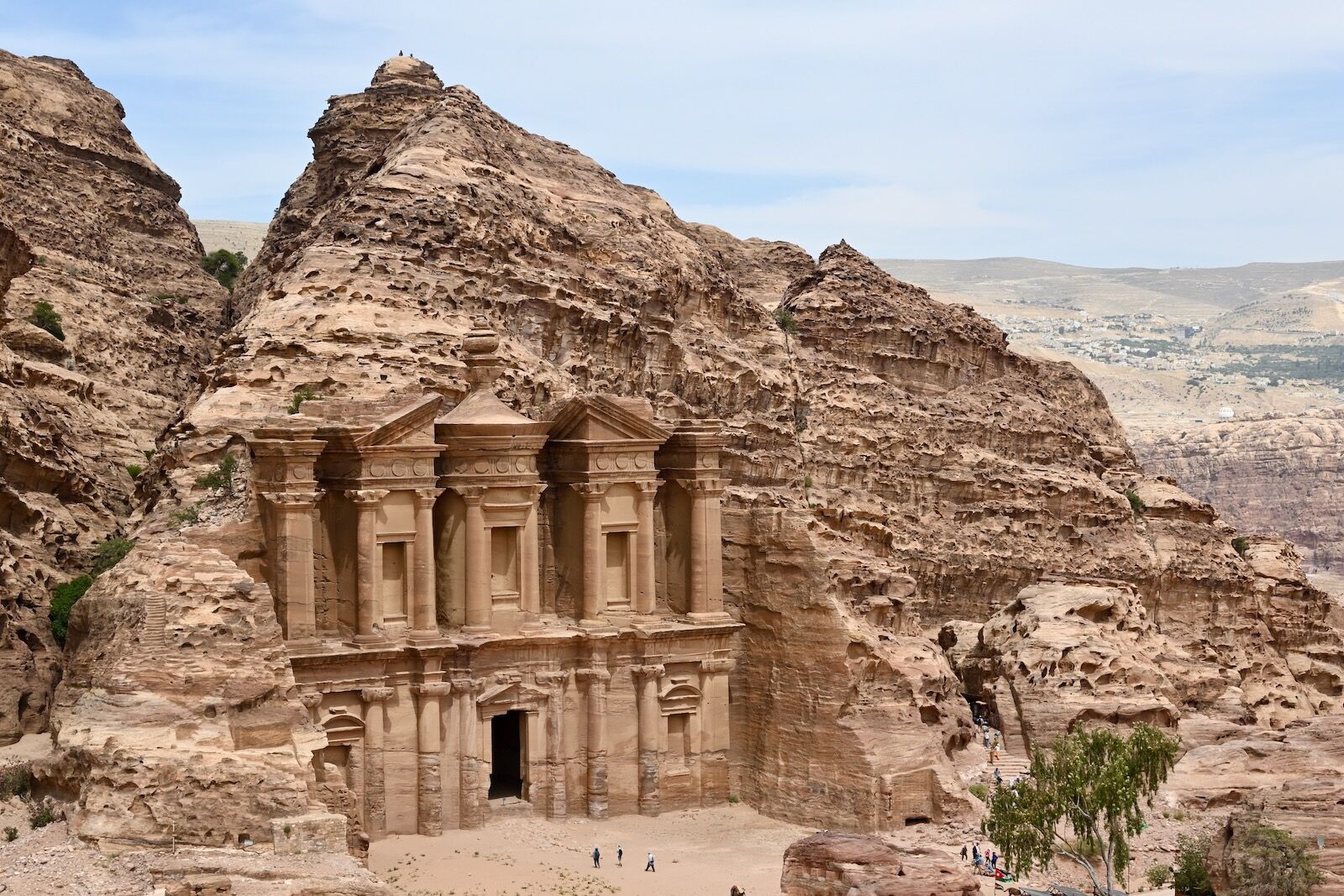
Photo: Noelle Salmi
The wealth that Nabateans amassed as traders financed the construction of cisterns, dams, and ornate mausoleums carved from the natural sandstone walls. The Siq walk ends at the first mausoleum, the Treasury, inaccurately named by early looters who hoped to find riches inside. Al Otaibi points out the motley mix of architectural styles and depictions of Egyptian, Roman, and Nabatean gods on the Treasury’s facade – probably carved to appeal to the Nabateans’ many trading partners.
Multiple tour groups have reached the Treasury before us, the midmorning sun has temporarily bleached the sandstone, and detritus of camels, horses, and donkeys leaves a faint, unpleasant odor. Retreating to a corner of the Treasury’s gulch, I order a coffee from local Bedouins. The small, steamy cup delivers a welcome new aroma. This time it is cardamom, a spice typically included in Arabic coffee.
Revived, I push on, trekking another two miles beyond the Treasury, leaving many tourists behind and passing endless caves and carvings. Two of us scale precariously etched steps to ledges that offer commanding views of the “Fortress City.” As afternoon sets in, we work our way back to the Petra entrance slowly. Few other tourists remain and the sandstone walls have taken on stunning sunset tones. Mesmerizing layers of pink, crimson, and burgundy explain Petra’s other nickname: “The Rose City.”
We have a hand in cooking dinner that evening, which introduces us to another Jordanian dish: maglouba, meaning “upside-down.” In a large soup pot, chicken is topped with vegetables like eggplant, potatoes, and cauliflower, with rice atop it all. Once it is cooked, the pot is turned over onto a platter and, with a flourish, lifted up to reveal a medley of meat and vegetables, which are then sprinkled with almonds or pine nuts.
Our day in Petra has made clear how the nutty eastern spices that flavor maglouba and color its rice, like cinnamon, turmeric, cardamom, cumin, and cloves, as well the rice itself, first made their way into this region of the world.
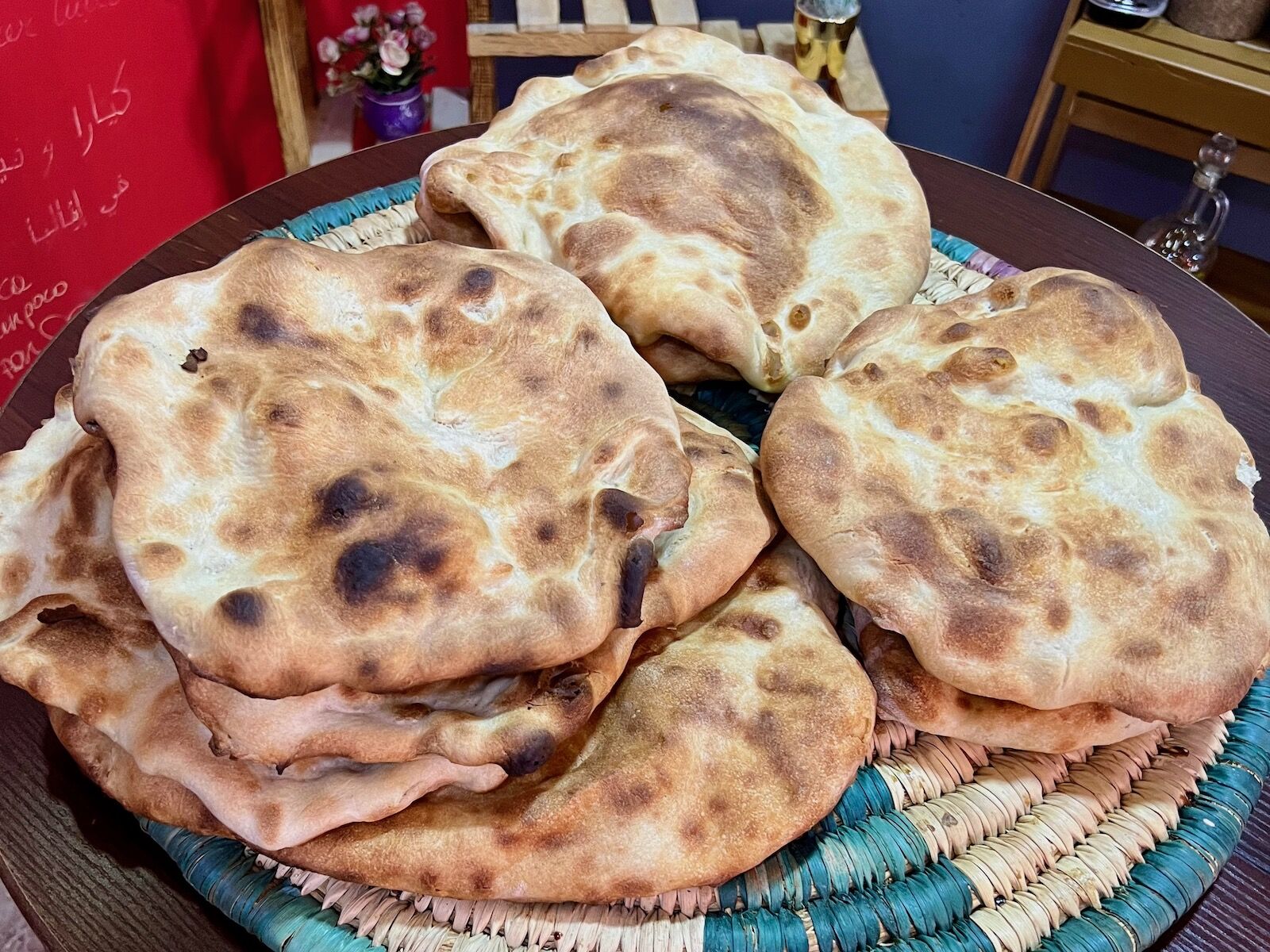
Photo: Noelle Salmi
While rice is a Jordanian mainstay, bread is equally vital. Quality is also so highly praised that at Amman’s elegant Tawaheen al-Hawa restaurant, a Bedouin woman in the front hall makes layer after layer of shrak, reassuring diners of the unleavened bread’s freshness.
After departing Petra the next day, we visit Sahtean Bakery in Al Taybeah village to make our own bread. This one, taboon, is named for the oven in which it’s cooked. In the past, this oven would have been carved into the ground and covered with a metal top. After first rising overnight, the rolled out dough would have been cooked atop hot stones inside the taboon – resulting in nubby, circular loaves.
At Sahtean, we roll out the loaves ourselves, but the hot stones on which we lay them occupy racks in commercially sized ovens. After five to six minutes in high heat, the crispy-soft, round loaves are removed and stacked, to be enjoyed immediately. We stand at a tall, round table and, using torn pieces of the just-baked taboon as spoons, dip into multiple mezes, like baba ganoush, hummus, and galayet, a sauce of sauteed tomatoes and onions flavored with garlic or cardamom.
Bakery owner Uday Khalayfeh, known as Lorans to western guests, and his family have also laid out sweet spreads. Lorans suggests I grab a chunk of halva, a powdery, sesame-seed candy, with the bread and then dip it into a bowl of date syrup. The rich, almost wine-like complexity of the sweet syrup is so unexpected that I ask Lorans how long it took to prepare. Five months, he replies.

Photo: Noelle Salmi
In the late afternoon, we drive into the Wadi Rum desert, whose dunes, mountains, and crags have served as settings for Star Wars, The Martian, Dune, and countless other films. They prove much weirder in real life. Tiers upon tiers of reddish rock appear to be crying tears of stone. After regarding a sunset even redder than the rocks, we return to Sky Village Camp, a collection of semi-permanent camel-hair tents tucked into a secluded arroyo.
We watch as a three-tiered metal tray that has been cooked under sand is unearthed, and we savor the flavors of the desert and spices from ancient Nabatean’s trade routes under the star-speckled sky. The meats and vegetables of the zarb, as this earth-cooked meal is called, are accompanied by a toothsome mezes and a tangy za’atar-seasoned fattoush salad. After dinner, we sit around the fire as our host Ibrahim Hlalat offers us cups of tea with our choice of herbs. I opt for mint and sage.
Dressed in a khaki Bedouin robe, Hlalat tells us that we are guests in his country and his desert, and we are most welcome. Sated from another unforgettable meal under a visible Milky Way and taking in the dreamy herbal scent of the tea, I feel Jordanian hospitality. I feel welcome.